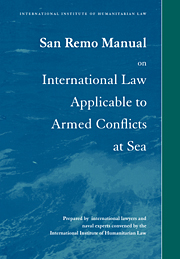 San Remo Manual on International Law Applicable to Armed Conflicts at Sea
San Remo Manual on International Law Applicable to Armed Conflicts at Sea Published online by Cambridge University Press: 04 August 2010
Section I Internal waters, territorial sea and archipelagic waters
Preliminary remarks
The paragraphs in this Part, together with paragraphs 10 and 12 of Part I of the Manual, were developed at the Ottawa (1992) session under the Madrid Plan of Action agenda item, Theatre of Operations in Naval Warfare – Different Maritime Areas. A session devoted to this subject was included in the Plan of Action in recognition of the changes that had been wrought in the jurisdictional areas or zones of the ocean since the customary rules for the conduct of armed conflict had crystallised during the nineteenth and early twentieth centuries. These changes were reflected in the 1982 United Nations Convention on the Law of the Sea and included a broadening of the territorial sea from three to twelve nautical miles, the recognition of several new zones denominated as the contiguous zone, the exclusive economic zone, the continental shelf and archipelagic waters, and the recognition of special navigational rights in these zones and through international straits. Although the 1982 United Nations Convention on the Law of the Sea is regarded as providing a peacetime regime for the law of the sea, the areas it defines subject to coastal State sovereignty or the exercise of other forms of national jurisdiction have a significant effect on the exercise of both belligerent and neutral rights during time of armed conflict. As stated by a noted authority on the law of the sea:
To the extent one continues to divide public international law into the two classic categories – the laws of war and the laws of peace – the Convention on the Law of the Sea would doubtlessly fall within the latter category …
To save this book to your Kindle, first ensure no-reply@cambridge.org is added to your Approved Personal Document E-mail List under your Personal Document Settings on the Manage Your Content and Devices page of your Amazon account. Then enter the ‘name’ part of your Kindle email address below. Find out more about saving to your Kindle.
Note you can select to save to either the @free.kindle.com or @kindle.com variations. ‘@free.kindle.com’ emails are free but can only be saved to your device when it is connected to wi-fi. ‘@kindle.com’ emails can be delivered even when you are not connected to wi-fi, but note that service fees apply.
Find out more about the Kindle Personal Document Service.
To save content items to your account, please confirm that you agree to abide by our usage policies. If this is the first time you use this feature, you will be asked to authorise Cambridge Core to connect with your account. Find out more about saving content to Dropbox.
To save content items to your account, please confirm that you agree to abide by our usage policies. If this is the first time you use this feature, you will be asked to authorise Cambridge Core to connect with your account. Find out more about saving content to Google Drive.